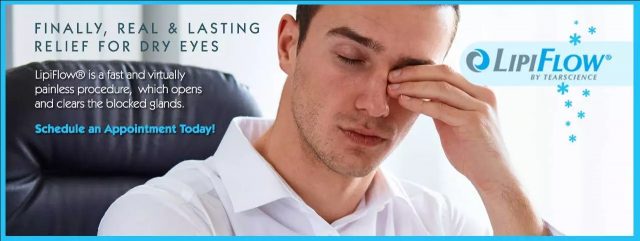What Is Dry Eye Syndrome?
Some people are unable to produce enough tears or the tears they do produce don’t possess the right qualities and ingredients to keep eyes healthy, comfortable and hydrated. A consistent lack of sufficient lubrication and moisture on the surface of the eye, known as dry eye syndrome, is often the result. Read more answers to dry eye questions here.
Normal, healthy eyes will constantly lubricate themselves by producing tears at a slow and steady rate, staying moist and comfortable most of the time. In order to accomplish this, healthy tears consist of three layers: an oily, a watery, and a mucus layer. Each layer has a specific role in lubricating your eyes, outlined below:
- The oily layer is on the outside. It’s main purpose is to cause the tear to evaporate as slowly as possible, keeping the eye wet.
- The watery layer is sandwiched in the middle, making up the majority of each tear. The water washes the eye of small foreign objects and particles.
- The core of each tear consists of mucus, which allows the watery layer to stick to the eye and spread evenly it, keeping it lubricated.
Unfortunately, if you have dry eyes, hormonal changes, side effects from medication or some other factor may be causing your eyes to either not produce enough tears, or leave out parts of the tear that make proper lubrication possible.

Symptoms of Dry Eye Syndrome
Dr. Kevin Rogers, of Rogers Regional Eye Center in Central, LA explains, “ There are many symptoms of dry eyes.
Stinging or burning in the eyes, scratchiness, and excessive irritation from smoke or wind are very common symptoms I see on a daily basis in my practice.
Although it may sound counter-intuitive, your eyes' response to consistent irritation caused by dry eye syndrome may also be to attempt to flush and lubricate itself by producing more tears, creating excessive tearing.
Unfortunately, with dry eye syndrome, your eyes are unable to hydrate themselves successfully due to the rate of evaporation or inability to spread the tears properly.”

Dry Eye Treatment And Prevention
Although dry eyes are not always curable, Dr. Rogers has many treatment options and professional tips to help combat the symptoms, and bring you comfort.
Seasonal Dry Eye
Some cases of dry eyes are seasonal, such as those which occur as a result of cold, dry winter air. In this case, Dr. Rogers may recommend:
Wearing sunglasses or goggles when outdoors to reduce your eyes' exposure to the sun, wind and dust. For indoors, your optometrist may recommend an air cleaner and humidifier to take dust out of the air and add moisture to air which is too dry.

Dry Eyes in the Elderly
Lack of moisture on the surface of the eye causes Dry Eyes. The elderly, particularly women, are prone to higher risks of this occurrence. Overall health contributes to this factor as well. Symptoms include itching, burning, eye irritation and blurry vision. It's best to have an appointment with a specialist for any treatment that may be needed.

Preventing Dry Eyes Through Nutrition
Studies have also shown that nutrition may have a part in helping to relieve some symptoms of dry eyes. Dr. Rogers may recommend: Nutritional supplements such as omega-3. Good sources of omega-3 fatty acids are cold-water fish, cod, herring and salmon, as well as flaxseed oil. Mild dehydration can make symptoms worse too, so be sure to drink plenty of water, 100 percent fruit and vegetable juices and milk.

What is Dry Eyes Q&A

Relieve your Dry Eyes with Lipiflow!

What is intense pulsed light for dry eyes?

We stare at screens all day long.

If you suffer from chronic dry eyes

Red eye and dry eye syndrome

If you've stopped wearing contact lenses because your eyes get irritated and dry, this is for you.
